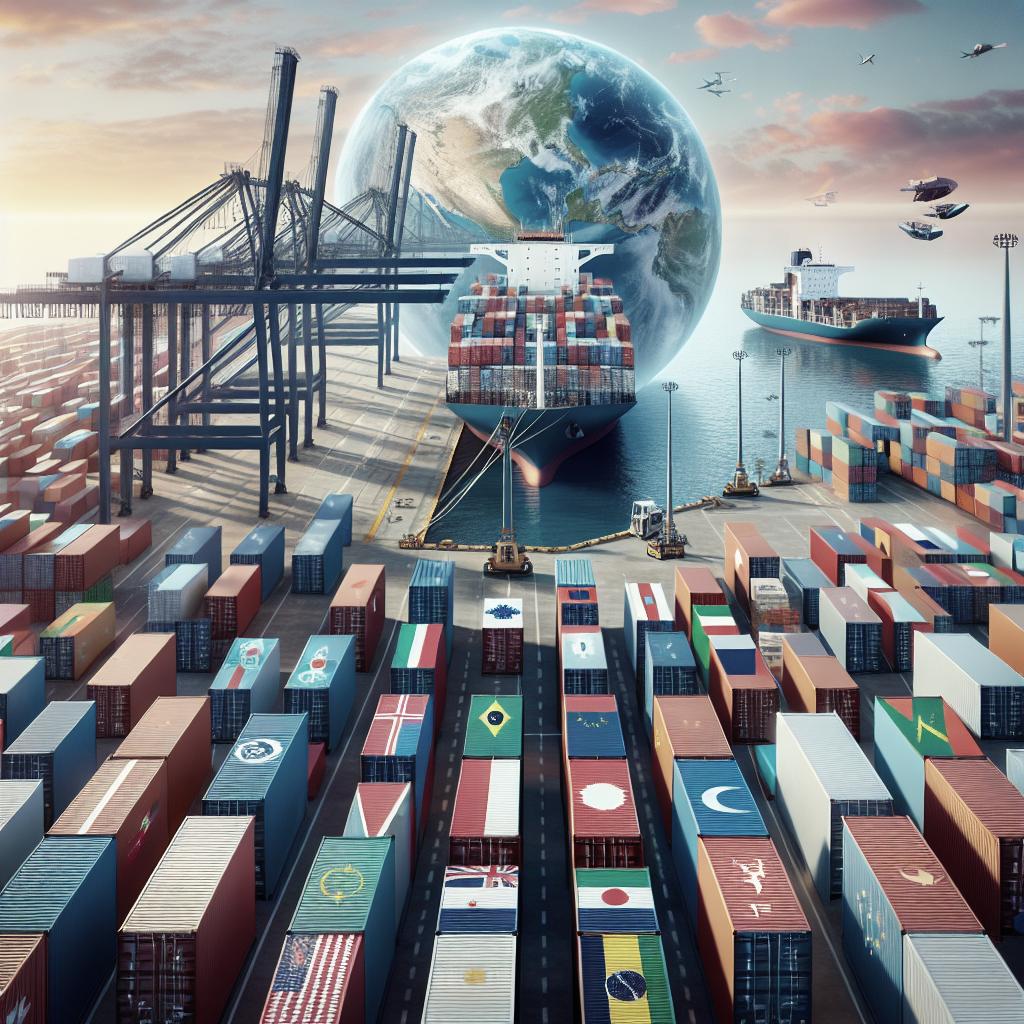The Impact of Globalization on Trade
Globalization has been a transformative force in reshaping international trade over the past century. This blog post explores its multifaceted impact by delving into the historical growth of trade, key economic concepts, and modern-day trade dynamics. We will examine two major waves of trade expansion, analyze the contemporary trade landscape, and discuss the benefits and challenges posed by globalization. Additionally, we’ll scrutinize the link between trade and various economic factors, such as economic growth, productivity, and household welfare. As globalization continues to evolve, understanding its influence on global trade remains crucial for navigating future economic prospects.
Trade has grown remarkably over the last century
The growth of trade in the last century has been nothing short of extraordinary. Advances in technology, transportation, and communication have made it easier than ever to exchange goods and services across borders. Economic policies favoring liberalization and free trade have further accelerated these exchanges, allowing countries to integrate into the global economy at an unprecedented pace.
This era of significant trade expansion is underpinned by an intricate web of inter-country dependencies, where countries specialize in producing goods and services where they have a comparative advantage. Consequently, the global market has become more interconnected and interdependent.
Related topics
In understanding the remarkable growth of trade, several related topics arise, which have implications for globalization. These include economic growth, inequality, and migration. Each plays a unique role in shaping the landscape of international trade, influencing how nations maneuver within a globalized economy.
Economic Growth
The link between trade and economic growth is both direct and indirect. Directly, trade enables countries to access larger markets, encouraging efficiency and driving innovation. Indirectly, it opens avenues for foreign investments and technological spillovers. As countries engage in trade, they are often able to leverage their strengths, resulting in GDP growth and increased economic activity.
Empirical studies have shown that countries engaging actively in international trade tend to experience higher economic growth rates. Trade allows for an optimal allocation of resources and efficient distribution of goods, leading to improvements in living standards.
Economic Inequality
While trade has facilitated economic growth, it can also lead to economic inequality. Benefits stemming from trade are not uniformly distributed, often resulting in disparities within and between nations. In developed countries, workers in declining industries may face job losses or wage stagnation due to competition from imports.
This uneven distribution has fueled debates on the fairness and inclusivity of the global trading system. Policymakers are challenged to balance the benefits of open trade while addressing the socio-economic disparities it might engender.
Migration
Trade and migration are interconnected facets of globalization. As trade extends opportunities across borders, labor mobility becomes a crucial component. Migrants often fill demand for labor in sectors bolstered by trade, contributing to the economic vitality of host nations.
However, the movement of people also poses challenges, such as cultural integration and the strain on local infrastructure. Despite these challenges, migration driven by trade demands remains a key piece in understanding globalization’s full impact.
The increase in trade has even outpaced economic growth
Trade’s expansion has surpassed even the rapid pace of economic growth. This phenomenon reflects an increased openness to international markets, where the scale of trade grows more rapidly than the underlying economy. The ratio of trade to global GDP highlights how intertwined global economies have become.
Multiple factors have contributed to this acceleration. The dismantling of trade barriers, advancement in logistics, and proliferation of digital commerce have all facilitated trade growth. Consequently, nations continue to seek new markets and integrate further into the global trade nexus even as their economies grow.
Trade expanded in two waves
The first “wave of globalization” started in the 19th century, the second one after WW2
Trade expansion occurred in two notable phases. The first wave began in the 19th century, driven by steamships, railroads, and the expansion of empires. This period saw a surge in international trade, particularly among European nations and their colonies, forming the backbone of early globalization.
The second wave took off post-World War II, supported by technological innovations, the formation of international institutions, and global treaties encouraging trade. This era marked significant trade liberalization and integration, resulting in more extensive global economic interdependence.
Before the first wave of globalization, trade was driven mostly by colonialism
Colonial powers established vast trade networks, extracting resources from colonies while selling finished goods back to them. This system of trade was characterized by an imbalanced flow of resources and wealth, primarily benefiting colonial powers at the expense of their colonies.
The legacy of colonial trading patterns still exerts influence in some regions, as former colonies grapple with integrating into a truly globalized trading system while addressing developmental disparities.
The first wave of globalization was marked by the rise and collapse of intra-European trade
The first wave also witnessed significant intra-European trade. Industrialization positioned Europe as the epicenter of global commerce and innovation, with technological advancements facilitating trade efficiency and expansion.
However, economic and political tensions eventually disrupted this expansion, and the Great Depression along with World War conflicts curtailed trade growth during the early 20th century.
The second wave of globalization was enabled by technology
The post-WWII period revitalized global trade through revolutionary technologies in telecommunications and transportation. Innovations like the containerization of shipping and creation of the internet have drastically reduced logistical costs and barriers.
These advancements have not only simplified international transactions but also supported the rise of multinational corporations and complex global supply chains, underpinning the modern globalized economy.
Trade and trade partners by country
Today, international trade involves a vast network of bilateral and multilateral partnerships among countries worldwide. The composition and value of trade differ significantly based on geopolitical, economic, and developmental statuses of trading partners.
In this intricate ecosystem, trade partnerships continue to evolve. Emerging economies pursue beneficial alliances to accelerate growth, while developed countries seek new markets and resources to sustain their economic positions. The dynamics within these partnerships reflect ongoing global economic shifts.
How much do countries trade?
Trade openness around the world
Trade openness varies across regions, depending on economic policies, geographic proximity to major trade routes, and historical trade relations. Some regions, like Europe and East Asia, exhibit high levels of openness, driven by regional free trade agreements and economic integration.
Conversely, some regions remain less open due to protective tariffs, political instability, or underdeveloped infrastructure. However, globalization’s pressure prompts many countries to increasingly participate in international markets, recognizing the benefits of trade openness for economic development.
Exports and imports in real dollars
Understanding trade volume in real dollars provides insights into the economic positions of countries. Major exporting countries like China, the U.S., and Germany, for instance, consistently report high trade surpluses, reflecting their competitive global market positions.
Conversely, import-dependent countries often show trade deficits, creating challenges in maintaining foreign exchange reserves and economic stability. Balancing trade on national scales remains a crucial endeavor for policy frameworks worldwide.
What do countries trade?
Trade in goods vs. trade in services
While traditional trade has focused on physical goods such as manufactured products and commodities, an increasing share of global trade involves services. These include finance, tourism, IT, and professional services, which have grown substantially with digitalization and globalization.
Trade in goods still constitutes a large part of international commerce. However, in an increasingly digitized world, service trade expansion represents an opportunity for countries to diversify their export portfolios and capitalize on emerging sectors.
How are trade partnerships changing?
Bilateral trade is becoming increasingly common
Countries continually seek to forge bilateral trade agreements to capture specific market benefits and address unique trade challenges. Such agreements allow countries to negotiate terms that best serve their economic interests, including tariffs, quotas, and standards.
These arrangements offer tailored frameworks that can lead to significant trade increases between the involved nations, fostering closer economic ties and cooperation in diverse sectors.
South-South trade is becoming increasingly important
The shift from traditional North-South trade dynamics to increased South-South trade reflects the rise of emerging economies. Countries within these emerging markets are trading more with each other, leveraging mutual developmental goals and economic complementarities.
This intra-regional trade boost helps build regional economies’ resilience, strengthen supply chains, and reduce dependence on developed countries’ markets.
The majority of preferential trade agreements are between emerging economies
The landscape of preferential trade agreements (PTAs) is predominantly characterized by relationships between emerging economies. These agreements facilitate lower trade barriers, enabling countries with similar developmental statuses to collaborate economically.
These PTAs often contain provisions addressing mutual interests such as investments, intellectual property rights, and labor standards, fostering sustainable regional economic integration.
Trading patterns have been changing quickly in middle-income countries
Middle-income countries are experiencing rapid transformations in their trading patterns. As their economies expand, they diversify trade, moving from low-value to high-value goods and services, often integrating into global value chains.
This evolution reflects their growing industrial capabilities, increased competitiveness, and strategic geographical positioning, further reinforced by active trade negotiations and agreements.
The raw correlation between trade and growth
Trade’s contribution to economic growth is multifaceted, involving complex interactions between market forces, policy choices, and external variables. A normative correlation suggests that countries with higher trade openness tend to experience accelerated growth rates.
However, the raw correlation masks underlying determinants such as capital investments, labor markets, and institutional quality, all critical elements behind economic expansion driven by trade.
Evidence from cross-country differences in trade, growth, and productivity
Cross-country empirical studies provide valuable insights into the diverse impacts of trade liberalization on economic growth and productivity. These studies highlight that while trade fosters growth generally, its distribution of benefits varies significantly across nations.
Developing countries often witness larger impacts due to initial structural transitions and untapped market potentials. In contrast, developed economies benefit slower from incremental changes attributed to already robust economic systems.
Evidence from changes in labor productivity at the firm level
The microeconomic impact of trade is evident in changes in firm-level productivity. Open trade policies allow firms to enter broader markets, gain access to inputs and technologies, and foster competitive environments enhancing efficiency and innovation.
In some sectors, increased competition can lead to consolidation, where more productive firms survive and expand while less competitive ones exit. This evolution results in overall industry productivity enhancements and economic growth.
Trade does not only increase efficiency gains
Beyond efficiency gains, trade introduces numerous additional benefits. It fosters market diversification, reducing reliance on domestic markets and creating avenues to absorb shocks. Trade also enriches consumer choices, leading to better quality and lower-priced goods and services.
However, recognizing trade-offs is vital. While trade benefits many, it can disrupt local industries and cause temporary dislocations, necessitating policies to cushion adverse effects and facilitate transitions to new competitive environments.
The conceptual link between trade and household welfare
Trade has a direct and profound connection with household welfare, impacting the cost of living, income levels, and employment opportunities. By enhancing productivity and economic growth, trade can uplift community living standards.
Nevertheless, this impact is heterogeneous, often skewed towards skilled workers or regions aligned with global markets. Ensuring equal distribution of trade benefits remains a policy priority to bolster household welfare inclusively.
The link between trade, jobs and wages
Evidence from Chinese imports and their impact on factory workers in the US
The rise of Chinese imports has shaped labor markets globally. In the U.S., this shift led to significant factory worker displacements in industries unable to compete with low-cost Chinese goods. This has sparked debates on trade policy reform and support for affected workers.
Evidence from the expansion of trade in India and the impact on poverty reductions
In contrast, India’s integration into global trade networks facilitated economic expansion and widespread poverty reduction. Increased exports have fostered job creation and income generation, substantially improving community welfare.
Evidence from other studies
Various studies draw diverse conclusions about trade’s impacts on jobs and wages, reflecting complex interplays of policies, industries, and local contexts. While some regions witness job loss and wage pressure, others experience job growth and wage increases, highlighting the need for adaptable trade policies.
The link between trade and the cost of living
Trade significantly influences the cost of living by affecting prices of goods and services available to consumers. Open markets allow for the importation of cheaper goods, enhancing purchasing power and overall consumer welfare.
However, price benefits must be achieved without undermining domestic industries vital for national economic health. Striking a balance between competitive pricing and local economic support is essential to optimize trade’s cost-of-living impact.
Implications of trade’s distributional effects
Trade’s distributional effects underscore the need for balanced policy frameworks ensuring that economic gains do not come at the expense of vulnerable sectors. Mechanisms such as compensatory transfers, job training programs, and infrastructure investments are crucial strategies.
Addressing these disparities holistically ensures that trade continues benefiting all societal segments, supporting sustainable development and enhancing economic inclusiveness.
Comparative advantage
Theory: What is ‘comparative advantage’ and why does it matter to understand trade?
Comparative advantage, a core trade theory, posits that countries should specialize in producing goods where they hold efficiency advantages, thereby maximizing global production and consumption benefits.
Is there empirical support for comparative-advantage theories of trade?
Empirical evidence supports comparative advantage as a vital determinant of international trade patterns. Countries adhering to their comparative advantages often reap significant economic efficiencies and competitive market positioning.
Trade diminishes with distance
Distance remains a critical determinant in trade activity. The cost of transportation, time, and logistical complexities often reduce the profitability of engaging in trade with far-flung regions.
Yet technological and logistical advances continue easing these barriers, promoting trade relationships previously considered untenable. Distance’s diminishing money factor marks an ongoing development in trade networks.
Institutions
Institutions play a crucial role in facilitating and regulating trade activities. Effective governance, legal frameworks, and economic infrastructures are pivotal for a favorable trade environment.
Countries with robust institutional setups often attract higher trade volumes, as they ensure efficient market operations, secure transactions, and reduced investment risks.
Increasing returns to scale
Increasing returns to scale highlight the efficiencies gained as production scales. In trade, larger production volumes often lead to cost reductions and improved competitiveness.
This economic principle underlies the strategic objective of many firms and nations to access global markets, seeking to expand and enhance productivity through economies of scale.
What data is available?
Understanding trade dynamics requires comprehensive data, including trade flows, tariff rates, sectoral outputs, and economic indicators. Various international organizations such as the WTO, IMF, and World Bank provide extensive trade databases.
Accessing accurate and timely data empowers policymakers, economists, and businesses to make informed decisions, tailor strategies, and address emerging trade challenges.
How large are the discrepancies between sources?
Data discrepancies often emerge from methodological differences in trade measurement and reporting across different institutions. These inconsistencies might stem from variations in data collection periods, categorization standards, or calculation methods.
Recognizing these differences is essential in ensuring realistic assessments of trade’s state and its impacts worldwide, requiring careful examination of the underlying methods used in data compilation.
Why doesn’t the data add up?
Differences in guidelines used by countries to record and report trade data
The guidelines for recording and reporting trade data vary significantly. Countries may adhere to disparate classification systems, valuation standards, and adjustment policies, resulting in inconsistent data.
Measurement error and other inconsistencies
Measurement errors arise from human mistakes, outdated methods, or technological limitations. Addressing these inaccuracies requires continual updates to data processing methodologies, advanced technologies, and coordinated international reporting efforts.
A checklist for comparing sources
Endnotes
In compiling trade data and analyses, meticulous referencing and methodological transparency are vital in ensuring data reliability and utility.
Cite this work
Proper citation allows for the traceability of information, fostering accountability and fostering collaborative knowledge ecosystems within trade research circles.
Reuse this work freely.
Encouraging the open and free use of work promotes broader dissemination of insights, knowledge sharing, and further advancement in understanding trade’s dynamic landscape.
| Section | Content Summary |
|---|---|
| Trade Growth | Explores the remarkable growth of trade over the last century and its implications on globalization. |
| Historical Waves of Trade | Analyzes the two major waves of trade expansion and their key characteristics. |
| Country Trade Relations | Discusses modern trade partnerships, trade openness, and trade volume by country. |
| Trade Composition | Examines what countries trade, highlighting goods versus services trade. |
| Changing Trade Partnerships | Describes shifts in bilateral agreements and emerging trends within trade networks. |
| Trade’s Economic Impact | Details the correlation between trade and economic outcomes such as growth, productivity, and household welfare. |
| Distributional Effects | Reviews the diverse impacts of trade on wages, jobs, and cost of living. |
| Trade Theories and Challenges | Explores theoretical underpinnings of trade like comparative advantage and real-world data challenges. |


